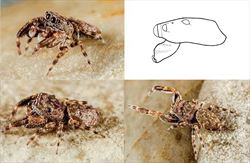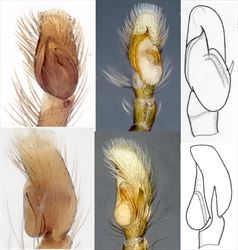
Examples of live Tara
Illustrators (and ©) I.R. Macaulay & M. Zabka (diag,) (QMB)

Aspects of the general morphology of Tara
Illustrators (and ©) R. Whyte, B.J. Richardson (LC, LB) (CSIRO) and M. Zabka (diag,) (QMB)

Palp morphology of Tara
Illustrators (and ©) B.J. Richardson (L), R. Whyte (C), M. Zabka (diag,) (QMB)

Epigyne morphology of Tara
Illustrator (and ©) B.J. Richardson (CSIRO, MP)
Tara Peckham & Peckham, 1886
Taxonomy
Tara has three Australian species: Tara anomala, T. gratiosa and T. parvula. There are many other undescribed species found across Australia (Whyte unpubl.) The genus is part of an Australasian clade (Maddison et al 2008) that includes the Australian genera Abracadabrella, Apricia, Clynotis, Holoplatys, Huntiglennia, Ocrisiona, Opisthoncus, Paraplatoides, Pungalina, Trite and Zebraplatys (Maddison 2015). Further information on the genus and described species can be found in Richardson and Żabka (2017) and Whyte and Anderson (2017).
Description
Species presently placed in Tara vary significantly in morphology, making the description ambiguous for many characters. Tara spp. are medium-sized spiders, ranging in body length from 3 to 7 mm. The head, viewed from above, can be rectangular with rounded sides, mildly pear-shaped or roughly triangular. It is widest either behind or in front of the posterior lateral eyes. The cephalothorax is high, peaking at the posterior median eyes or it can be low and flat. Chelicerae have a many-cusped (plurident) retromarginal tooth on a distinct base or a two-cusped (fissident) retromarginal tooth. There are two to four promarginal teeth. The abdomen is ovate to elongate-ovate. In the male the first pair of legs is longer and heavier than the others. The fourth pair is longest in the female. The spines on the tibia and tarsus of the first pair of legs are well developed.
The male’s palp has an embolus arising on the distal edge of the tegulum, varying from very short to medium in length. The tegulum is roughly rectangular, without a proximal lobe. The palpal tibia has a single, short to medium-length, tapering, sharp retro-lateral tibial apophysis.
The female epigyne has a single, barely-discernible atrium. Copulatory openings are usually located on the lateral edges of the atrium. The insemination ducts lead posteriorly in a lateral curve to join anterior edges of roundish spermathecae. These open into large, variously-shaped diverticulae either lateral to or between the spermathecae.
Biology
Tara has been collected in litter and on foliage in habitats ranging from open woodland and heathland through riparian zones to rainforest.
Distribution
Tara has been collected throughout the higher rainfall areas of mainland Australia and Tasmania. Tara gratiosa is endemic to Lord Howe Island.
References
Davies, V.T. & Żabka, M. 1989. Illustrated keys to the genera of jumping spiders (Araneae: Salticidae) in Australia. Memoirs of the Queensland Museum 27, 189-266.
Maddison, W.P. 2015. A phylogenetic classification of jumping spiders (Araneae: Salticidae). Journal of Arachnology 43, 231-292.
Maddison, W.P., Bodner, M.R. & Needham, K.M. 2008. Salticid spider phylogeny revisited, with the discovery of a large Australian clade (Araneae: Salticidae). Zootaxa 1893, 49-64.
Richardson, B.J. 2016. New genera, new species and redescriptions of Australian jumping spiders (Araneae, Salticidae). Zootaxa 4114, 501-560.
Richardson, B.J. & Żabka , M. 2016. Salticidae. Arachnida: Araneomorphae. Canberra, Australian Faunal Directory. Australian Biological Resources Study, at https://biodiversity.org.au/afd/taxa/SALTICIDAE.
Żabka, M. 1987. Salticidae (Araneae) of Oriental, Australian and Pacific Regions, I. Genera Clynotis and Tara. Annales Zoologici, Warszawa 40, 437-450.
Whyte, R. and Anderson, G. 2017. A field guide to the spiders of Australia. Clayton: CSIRO Publishing 451pp.
* The information sheet should be read in the context of the associated diagrams and photographs. Diagrams explaining anatomical terms can be found in the ‘Salticidae’ pictures at the beginning of the list of genera.